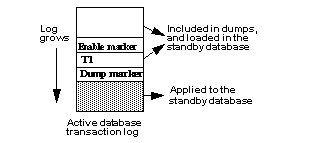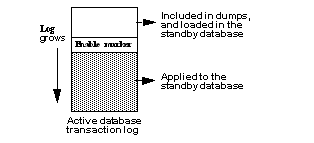You initialize the standby database with data from the active database. To do this, use these Adaptive Server commands and utilities:
dump and load, or
bcp, or
quiesce database ... to manifest_file and mount.
Replication Server writes an “enable replication” marker into the active database transaction log when you add the standby database using Sybase Central or rs_init. Adaptive Server writes a dump marker into the active database transaction log when you perform a dump operation—either a dump database or a dump transaction.
If you do not suspend transaction processing during initialization:
Choose the “dump marker” option in Sybase Central or rs_init, and use the dump and load commands.
If you suspend transaction processing during initialization:
Do not choose the “dump marker” option in Sybase Central or rs_init, and use the dump and load commands, or
Use bcp, or
Use quiesce database ... to manifest_file and mount.
Table 3-4 summarizes each of the initialization methods and the role of these markers.
Issue |
Use dump and load with “dump marker” |
Use dump and load without “dump marker” |
Use bcp |
Use mount |
|---|---|---|---|---|
Working with client applications. |
Use if you can not suspend transaction processing for client applications. |
Use if you can suspend transaction processing for client applications. |
Use if you can suspend transaction processing for client applications. |
|
When does Replication Server begin replicating into the standby database? |
Replication Server starts replicating into the standby database from the first dump marker after the enable replication marker. |
Replication Server starts replicating into the standby database from the enable replication marker. |
Replication Server starts replicating into the standby database from the enable replication marker. |
|
Creating maintenance user login names and making sure all user IDs match. |
Add the login name for the standby database maintenance user in both the active Adaptive Server and the standby Adaptive Server, and ensure that the server user’s IDs match. (You create login names in the active Adaptive Server because using dump and load to initialize the standby database with data from the active database overrides any previous contents of the standby database with the contents of the active database.) |
When you add the standby database, Sybase Central or rs_init adds the maintenance user login name and user in the standby Adaptive Server and the standby database. |
Add the login name for the standby database maintenance user in both the active and standby Adaptive Servers. Ensure that the server user’s IDs match. (You create login names in the active Adaptive Server because using mount to initialize the standby database with data from the active database overrides any previous contents of the standby database with the contents of the active database.) |
|
Initializing standby database. |
Use dump and load to transfer data from the active database to the standby database. You can use database dumps and/or transaction dumps. |
Use bcp to copy each replicated table from the active database to the standby database. |
Use quiesce database ... to manifest_file and mount database to transfer data from the active database to the standby database. |
|
Active database connection state. |
The connection to the active database does not change. |
Replication Server suspends the connection to the active database. |
Replication Server suspends the connection to the active database. |
|
Resuming connections. |
Resume connection to the standby database. |
Resume connections to the active and standby databases; resume transaction processing in the active database. |
Resume connections to the active and standby database; resume transaction processing in the active database. |
|
If you do not suspend transaction processing for the active database while initializing the standby database, choose the “dump marker” option when you add the standby database. Then initialize the standby database by using the dump and load commands.
Replication Server starts replicating into the standby database from the first dump marker after the enable replication marker in the transaction log of the active database.
In Figure 3-2, transaction T1, executed after you added the standby database, appears after the enable replication marker in the log. T1 is included in dumps, so it is present in the standby database after you have loaded the dumps. Replication Server does not need to replicate it into the standby database.
Figure 3-2: Using dump and load with dump marker

Transactions can be executed in the active database between the time the enable replication marker is written and the time the data in the active database is dumped.
You can load the last full database dump and any subsequent transaction dumps into the standby database until both markers have been received and the standby database is ready for operation. Then, optionally, you can use a final transaction dump of the active database to bring the standby database up to date. Any transactions not included in dumps will be replicated.
Replication Server does not replicate transactions from the active to the standby database until it has received both the enable replication marker and the first subsequent dump marker. After receiving both markers, Replication Server starts executing transactions in the standby database.
See Table 3-4 for more information about this method.
If you suspend transaction processing for the active database while initializing the standby database, do not choose the “dump marker” option when you add the standby database. You can initialize the standby database by using the dump and load commands, by using bcp, or by using mount.
Replication Server starts replicating into the standby database from the enable replication marker in the transaction log of the active database. No transactions occur after the enable replication marker, because client applications are suspended.
Figure 3-3: Using dump and load without dump marker, or using bcp

As shown in Figure 3-3, no transactions are executed in the active database between the time the enable replication marker is written and the time the data in the active database is dumped using the dump command, or copied using bcp or mount.
You can load the last full database dump or the last set of replicated tables copied with bcp into the standby database until the standby database receives the enable replication marker.
After receiving this marker, Replication Server starts executing transactions in the standby database.